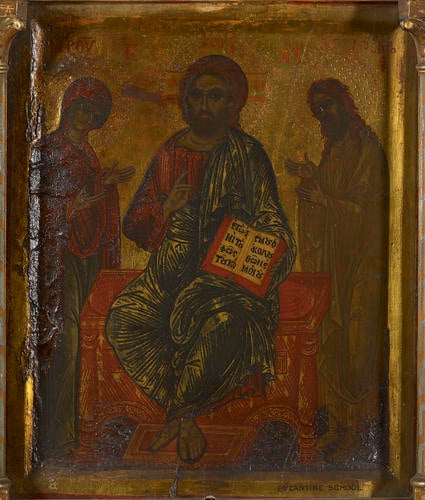-
1 of 253523 objects
Christ Pantocrator with the Virgin and St John the Baptist ('The Deisis') c.1400-1600
Panel | 24.8 x 20.4 cm (support, canvas/panel/stretcher external) | RCIN 403476

Byzantine School
Christ Pantocrator with the Virgin and St John the Baptist ('The Deisis') c.1400-1600
-
The term 'Byzantine' is used to refer to the art which emanated from the Eastern Christian Empire from the fourth century onwards, the capital of which was Byzantium or Constantinople, now Istanbul in Turkey. The term can often refer to a style, rather than a geographic place, and Byzantine painting is recognisable by its formulaic appearance, highly-stylised figures and rich colours.
This painting is a type of devotional image known as an icon, acting as a window through which the viewer can interact with the holy subjects within. Here, Christ is depicted in a format known as Christ Pantocrator, or 'Ruler of All', in which he prepares to judge the souls of mankind. With a fixed gaze, he raises his right hand in blessing and holds open the words of the Gospel in his left, which translate as 'I am the light of the world; he that follows me shall not walk in darkness'. The Virgin Mary and Saint John the Baptist stand either side of the throne. With hands extended in supplication, they are present to act as intercessors on behalf of both the viewer and all of humanity who will appear before Christ to be judged. Icons depict a sacred and infinite presence, and so resist any reference to a set time or place. Here, the characteristic gold background removes the holy figures from everyday, earthly reality.
This type of composition, featuring Christ, the Virgin and Saint John, makes up a format known as the 'Deisis' (or 'Deesis'), which can be translated as 'the intercession'. In Eastern Orthodox Churches, from the Middle Byzantine period onwards, the three figures of the Deisis could often be found in the upper centre of the altar screen (templon) which separated the holiest part of a church from the main area containing the congregation. Lay people could approach the screen to pray, and to venerate and contemplate the icons placed there, all the while reminded of the importance of the intercession of the Virgin and the saints.
Provenance
One of the group of Byzantine works from the 77 paintings belonging to Prince Ludwig von Oettingen-Wallerstein (1791-1870); these were first offered to Prince Albert in 1847 as security for a loan and came into his possession by default (no 2 in Waagen’s catalogue of 1854); 25 of them were accepted by the National Gallery in 1863.
-
Medium and techniques
Panel
Measurements
24.8 x 20.4 cm (support, canvas/panel/stretcher external)
46.2 x 28.7 x 4.4 cm (frame, external)
Category
Object type(s)
Alternative title(s)
Salvator Mundi